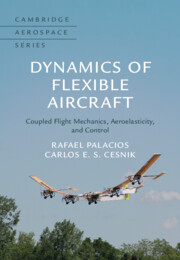Book contents
- Frontmatter
- Dedication
- Contents
- Preface
- Symbols
- 1 Introduction
- 2 The Nonstationary Atmosphere
- 3 Dynamics of Elastically Supported Rigid Airfoils
- 4 Dynamics of Rigid Aircraft in a Nonstationary Atmosphere
- 5 Dynamics of Flexible Aircraft with Quasi-Steady Deformations
- 6 Dynamics of Flexible Aircraft with Small-Amplitude Vibrations
- 7 Time-Domain Unsteady Aerodynamics for Low-Speed Flight
- 8 Geometrically Nonlinear Composite Beams
- 9 Dynamics of Very Flexible Aircraft
- 10 Feedback Control
- Experimental Testing
- Appendix A The Fourier Transform
- Appendix B Von Kármán Model for Isotropic Turbulence
- Appendix C Finite Rotations
- References
- Index
2 - The Nonstationary Atmosphere
Published online by Cambridge University Press: 29 June 2023
- Frontmatter
- Dedication
- Contents
- Preface
- Symbols
- 1 Introduction
- 2 The Nonstationary Atmosphere
- 3 Dynamics of Elastically Supported Rigid Airfoils
- 4 Dynamics of Rigid Aircraft in a Nonstationary Atmosphere
- 5 Dynamics of Flexible Aircraft with Quasi-Steady Deformations
- 6 Dynamics of Flexible Aircraft with Small-Amplitude Vibrations
- 7 Time-Domain Unsteady Aerodynamics for Low-Speed Flight
- 8 Geometrically Nonlinear Composite Beams
- 9 Dynamics of Very Flexible Aircraft
- 10 Feedback Control
- Experimental Testing
- Appendix A The Fourier Transform
- Appendix B Von Kármán Model for Isotropic Turbulence
- Appendix C Finite Rotations
- References
- Index
Summary
This chapter describes the various situations in which the incoming flow on an aircraft may be non-stationary, as well as the mathematical models typically used to incorporate them in engineering analysis. Starting from the standard atmosphere, it discusses continuous turbulence, discrete wind gusts and flight in atmospheric boundary layers and wakes.
- Type
- Chapter
- Information
- Dynamics of Flexible AircraftCoupled Flight Mechanics, Aeroelasticity, and Control, pp. 35 - 72Publisher: Cambridge University PressPrint publication year: 2023

